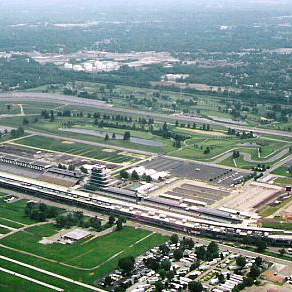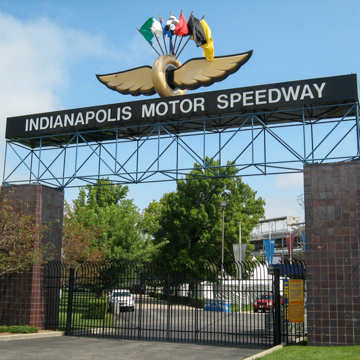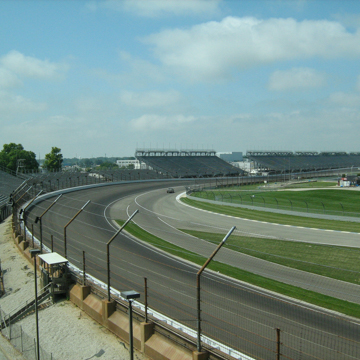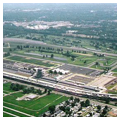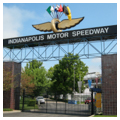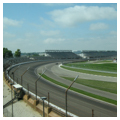You are here
Indianapolis Motor Speedway
The Indianapolis Motor Speedway is the oldest continuously operating automobile race course in the world and the most intact example of an early-twentieth-century high-speed auto race course in the United States. Memorial Day 2016 marked the 100th running of the Indianapolis 500 at the site, the largest single-day spectator sporting event in the world.
Racing enthusiast Carl G. Fisher, co-owner of Indianapolis’s Presto-Lite Corporation, first envisioned the construction of a speedway after visiting Europe in the early twentieth century. Touring European facilities for racing and automobile testing, Fisher was impressed by their designs in contrast to the United States, where such activities took place on dirt horse tracks and public roads, both of which were unsuited for safe driving at high speeds. Fisher understood the need for an American speedway facility and thought that Indianapolis, with its early tradition in automobile manufacturing, was the ideal location. He gathered three other partners: James A. Allison, co-owner of the Presto-Lite Corporation, makers of carbide auto head lamps; Arthur C. Newby, officer of the National Motor Vehicle Company, an Indianapolis automaker; and Frank H. Wheeler, majority-owner of the Schebler Carburetor Company.
In 1908, these four founders purchased 320 acres northwest of Indianapolis and immediately started construction of the facility, which was completed in 1909. The Indianapolis Motor Speedway (IMS) originally included an oval racetrack, spectator grandstands on the west side of the track, garage areas, 33 “pits” on the infield side across from the stands to service cars during a race, and a one-story wooden platform used as a “scoring tower.” The 2.5-mile curved track had two long stretches of 5/8 of a mile, two short stretches or “chutes” each 1/8 mile, and four quarter-mile turns banked at just over 9 degrees. The track was originally surfaced with macadam, a mixture of crushed stone, shale, and tar. IMS was the first U.S. racing facility to be given the title of “speedway.”
The first event held at the IMS was not related to automobiles, but was the starting point for a local balloon race in early summer 1909. A few motorcycle races followed, and the first auto race was finally held on August 19, 1909. The original track surface failed immediately, resulting in three casualties during this first race. The macadam was immediately replaced with a roadbed of 3 million brick pavers, giving the track its nickname of “The Brickyard.”
The owners organized the first “International 500 Mile Sweepstakes” race on Memorial Day 1911. The race was only open to cars with engines with a 600 cubic-inch displacement. The 500-mile race was intended to be an endurance event that tested the reliability of innovations in the growing auto industry. The event attracted the best drivers of the era, who circled the track 200 times in about 6 hours. Ray Harroun won the event driving a Marmon Wasp with an average speed of 74.59 miles per hour. After the success of the first 500 mile race, the owners decided to hold an annual event on or near Memorial Day weekend, renaming it the Indianapolis 500. The race has been held every year since except for during World War II. Today, enough permanent grandstands have been added to seat 235,000 people, with additional seating in the infield bringing the total capacity to about 400,000 spectators.
Fisher and his partners sold the IMS to Captain Edward V. Rickenbacker in 1927. Rickenbacker, best known as a World War I flying ace, was also a retired auto racer who drove in the speedway’s first 500 event in 1911. Anton (Tony) Hulman of Terre Haute, Indiana, purchased the IMS in 1945. Although he died in 1977, his family continues to own the complex and gives the “start your engines” announcement at the beginning of every Indianapolis 500.
Although the complex’s layout remains similar to the original plan, the individual structures have been replaced or altered over the years to meet the demands of modern high-speed racing. Banking and safety aprons were added to the turns in 1935–1936; these devices are continually upgraded to make the track, which was designed for speeds of 75-80 miles per hour, safer for today’s speeds of over 225. The original 1909 brick track was covered with asphalt in 1937; all traces of the historic roadbed disappeared except for one yard exposed at the track’s start/finish line. After World War II, the original wooden grandstands were gradually replaced by the existing concrete and steel stands. The IMS Corporation added a modern office building and museum to the south end of the infield in 1976. An infield road course of 2.605 miles was added in 1998–2000 for the U.S. Grand Prix auto race; the course was modified in 2008 to a length of 2.621 miles.
The scoring tower “Pagoda” is one of the most visible and recognizable symbols of the IMS. The first structure was a simple, one-story wood platform that was replaced in 1911 with a frame tower with four decks. Each deck was covered with a hipped roof, making the structure resemble a pagoda, hence the nickname. This Pagoda burned in 1925 and was immediately replaced with a similar but slightly larger tower. In 1957, the second tower was replaced with the third Pagoda, a seven-story sleek steel, concrete, and glass structure influenced by contemporary modernist architecture.
The complex became a National Historic Landmark in 1987, and has had a significant impact on its surrounding community. When the track was originally constructed, it was well north of the boundaries of Indianapolis. In 1912, Fisher and his IMS partners platted the Indianapolis suburb of Speedway City; the downtown commercial district was to be just blocks from the track. This residential community was planned to serve the nearby automobile and aircraft engine industries. Modest bungalows were erected for workers, while plant managers owned larger houses. Today, the town of Speedway sits within an ever-expanding Indianapolis. The community has grown around the track, which is surrounded by hundreds of acres of parking lots that accommodate fans on race days.
References
Charleton, James. H., “Indianapolis Motor Speedway,” Marion County, Indiana. National Register of Historic Places Inventory-Nomination, 1987. National Park Service, U.S. Department of the Interior, Washington, D.C.
“Indianapolis Motor Speedway – History.” Indianapolis Motor Speedway, LLC. Accessed April 19, 2017. www.indianapolismotorspeedway.com/history.
Writing Credits
If SAH Archipedia has been useful to you, please consider supporting it.
SAH Archipedia tells the story of the United States through its buildings, landscapes, and cities. This freely available resource empowers the public with authoritative knowledge that deepens their understanding and appreciation of the built environment. But the Society of Architectural Historians, which created SAH Archipedia with University of Virginia Press, needs your support to maintain the high-caliber research, writing, photography, cartography, editing, design, and programming that make SAH Archipedia a trusted online resource available to all who value the history of place, heritage tourism, and learning.





